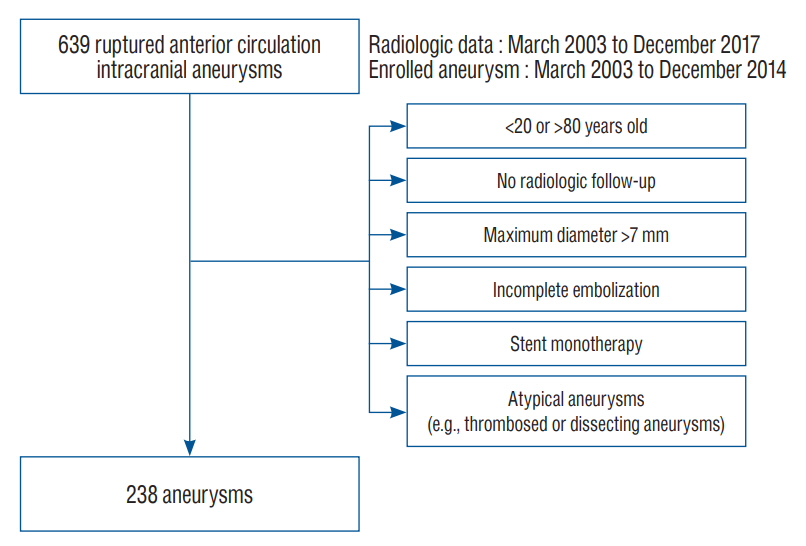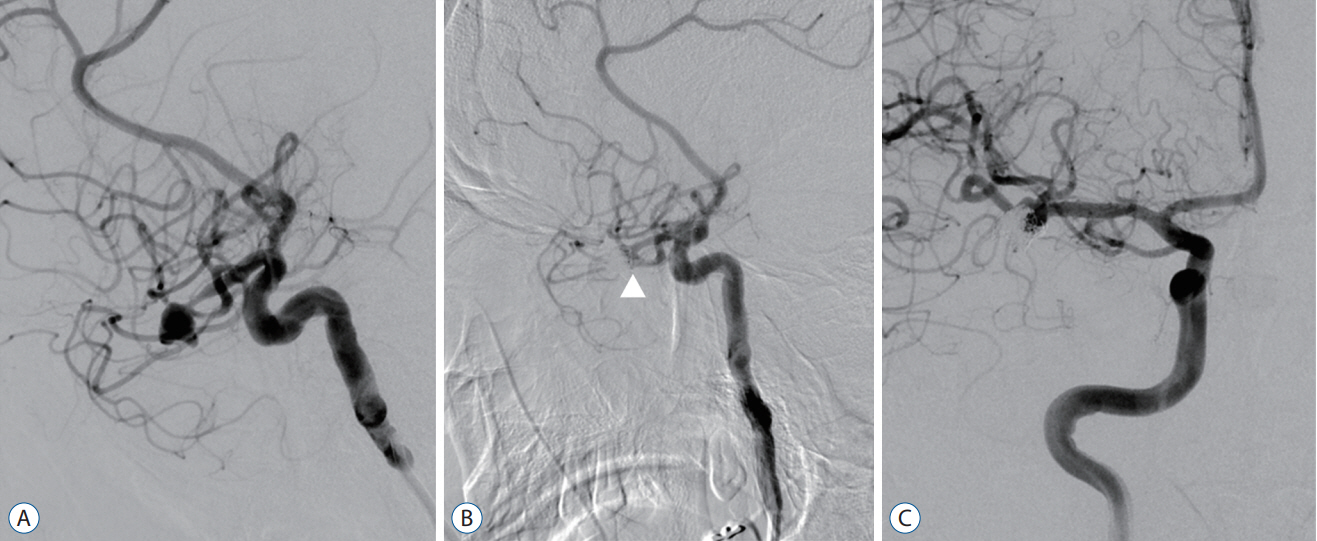J Korean Neurosurg Soc.
2022 Sep;65(5):710-718. 10.3340/jkns.2022.0088.
Angiographic Follow-Up for Small Ruptured Intracranial Aneurysm Treated by Endovascular Treatment : Follow-Up Plan and Long-Term Follow-Up Results
- Affiliations
-
- 1Department of Neurosurgery, Dankook University Hospital, Cheonan, Korea
- 2Department of Neurosurgery, College of Medicine, Dankook University, Cheonan, Korea
- KMID: 2533033
- DOI: http://doi.org/10.3340/jkns.2022.0088
Abstract
Objective
: Although endovascular treatment for intracranial aneurysms is considered effective and safe, its durability is still debated. Also, few studies have described angiographic follow-up plan after endovascular treatment of intracranial aneurysm, especially in ruptured cases. Hence, we report the long-term results of follow-up angiography protocol.
Methods
: Radiological records of 639 cases of coil embolization with ruptured aneurysms from March 2003 to December 2016 were retrospectively reviewed. Patients who received treatment of a saccular aneurysm less than 7 mm resulted with near complete occlusion were included. Two hundred thirty-eight aneuryms which received the follow-up angiography at least once were enrolled. We classified four periods of follow-up as follows : post-treatment 1 year (defined as the first period), from 1 to 2 years (the second period), 2 to 5 years (the third period), and over 5 years (long-term).
Results
: We identified 14 cases (6.4%) of recurrence from 218 aneurysms in follow-up angiography in the first period. Among 143 aneurysms in the second period, five cases (3.5%) of recurrence were identified. There were no findings suspicious of recanalization in 97 patients in the third period. Of the total 238 cases, there were 19 recurrences, for a recurrence rate of 8.0%. Six (31.6%) out of 19 recurrences showed a tendency toward repeat recurrences even after additional treatment. Twenty-eight received long-term follow-up over 5 years and there was no recurrence.
Conclusion
: Most of the recurrence were found during the first and the second year. We suggest that at least one digital subtraction angiography examination may be necessary around post-treatment 2 years, especially in ruptured cases. If the angiographic results are favorable at 2 years post-treatment, long-term result should be favorable.
Figure
Reference
-
References
1. Aguilar-Salinas P, Brasiliense LB, Santos R, Cortez G, Gonsales D, Aghaebrahim A, et al. Safety and efficacy of stent-assisted coiling in the treatment of unruptured wide-necked intracranial aneurysms: a single-center experience. Cureus. 11:e4847. 2019.2. Anzalone N, Righi C, Simionato F, Scomazzoni F, Pagani G, Calori G, et al. Three-dimensional time-of-flight MR angiography in the evaluation of intracranial aneurysms treated with Guglielmi detachable coils. AJNR Am J Neuroradiol. 21:746–752. 2000.3. Behme D, Weber A, Kowoll A, Berlis A, Burke TH, Weber W. Low-profile visualized intraluminal support device (LVIS Jr) as a novel tool in the treatment of wide-necked intracranial aneurysms: initial experience in 32 cases. J Neurointerv Surg. 7:281–285. 2015.4. Biondi A, Janardhan V, Katz JM, Salvaggio K, Riina HA, Gobin YP. Neuroform stent-assisted coil embolization of wide-neck intracranial aneurysms: strategies in stent deployment and midterm follow-up. Neurosurgery. 61:460–469. 2007.5. Brinjikji W, Rabinstein AA, Nasr DM, Lanzino G, Kallmes DF, Cloft HJ. Better outcomes with treatment by coiling relative to clipping of unruptured intracranial aneurysms in the United States, 2001-2008. AJNR Am J Neuroradiol. 32:1071–1075. 2011.6. CARAT Investigators. Rates of delayed rebleeding from intracranial aneurysms are low after surgical and endovascular treatment. Stroke. 37:1437–1442. 2006.7. Cognard C, Pierot L, Anxionnat R, Ricolfi F. Results of embolization used as the first treatment choice in a consecutive nonselected population of ruptured aneurysms: clinical results of the Clarity GDC study. Neurosurgery. 69:837–842. 2011.8. Deutschmann HA, Augustin M, Simbrunner J, Unger B, Schoellnast H, Fritz GA, et al. Diagnostic accuracy of 3D time-of-flight MR angiography compared with digital subtraction angiography for follow-up of coiled intracranial aneurysms: influence of aneurysm size. AJNR Am J Neuroradiol. 28:628–634. 2007.9. Feng X, Qian Z, Liu P, Zhang B, Wang L, Guo E, et al. Comparison of recanalization and in-stent stenosis between the low-profile visualized intraluminal support stent and enterprise stent-assisted coiling for 254 intracranial aneurysms. World Neurosurg. 109:e99–e104. 2018.10. Ferns SP, Sprengers ME, van Rooij WJ, Rinkel GJ, van Rijn JC, Bipat S, et al. Coiling of intracranial aneurysms: a systematic review on initial occlusion and reopening and retreatment rates. Stroke. 40:e523–e529. 2009.11. Fukuda K, Higashi T, Okawa M, Iwaasa M, Yoshioka T, Inoue T. White-collar sign as a predictor of outcome after endovascular treatment for cerebral aneurysms. J Neurosurg. 126:831–837. 2017.12. Gupta V, Chugh M, Jha AN, Walia BS, Vaishya S. Coil embolization of very small (2 mm or smaller) berry aneurysms: feasibility and technical issues. AJNR Am J Neuroradiol. 30:308–314. 2009.13. Hope JK, Byrne JV, Molyneux AJ. Factors influencing successful angiographic occlusion of aneurysms treated by coil embolization. AJNR Am J Neuroradiol. 20:391–399. 1999.14. Krag CH, Speiser L, Dalby RB. Long-term outcomes of endovascular simple coiling versus neurosurgical clipping of unruptured intracranial aneurysms: a systematic review and meta-analysis. J Neurol Sci. 422:117338. 2021.15. Kwak Y, Son W, Kim YS, Park J, Kang DH. Discrepancy between MRA and DSA in identifying the shape of small intracranial aneurysms. J Neurosurg. 134:1887–1893. 2020.16. Lawson MF, Newman WC, Chi YY, Mocco JD, Hoh BL. Stent-associated flow remodeling causes further occlusion of incompletely coiled aneurysms. Neurosurgery. 69:598–604. 2011.17. Mansour O, Megahed M, Schumacher M, Weber J, Khalil M. Coiling of ruptured tiny cerebral aneurysms, feasibility, safety, and durability at midterm follow-up, and individual experience. Clin Neuroradiol. 23:103–111. 2013.18. Mascitelli JR, Moyle H, Oermann EK, Polykarpou MF, Patel AA, Doshi AH, et al. An update to the Raymond-Roy Occlusion classification of intracranial aneurysms treated with coil embolization. J Neurointerv Surg. 7:496–502. 2015.19. Molyneux A, Kerr R, Stratton I, Sandercock P, Clarke M, Shrimpton J, et al. International subarachnoid aneurysm trial (ISAT) of neurosurgical clipping versus endovascular coiling in 2143 patients with ruptured intracranial aneurysms: a randomised trial. Lancet. 360:1267–1274. 2002.20. Molyneux AJ, Birks J, Clarke A, Sneade M, Kerr RS. The durability of endovascular coiling versus neurosurgical clipping of ruptured cerebral aneurysms: 18 year follow-up of the UK cohort of the International subarachnoid aneurysm trial (ISAT). Lancet. 385:691–697. 2015.21. Molyneux AJ, Kerr RS, Yu LM, Clarke M, Sneade M, Yarnold JA, et al. International subarachnoid aneurysm trial (ISAT) of neurosurgical clipping versus endovascular coiling in 2143 patients with ruptured intracranial aneurysms: a randomised comparison of effects on survival, dependency, seizures, rebleeding, subgroups, and aneurysm occlusion. Lancet. 366:809–817. 2005.22. Nguyen TN, Hoh BL, Amin-Hanjani S, Pryor JC, Ogilvy CS. Comparison of ruptured vs unruptured aneurysms in recanalization after coil embolization. Surg Neurol. 68:19–23. 2007.23. Ogilvy CS, Chua MH, Fusco MR, Reddy AS, Thomas AJ. Stratification of recanalization for patients with endovascular treatment of intracranial aneurysms. Neurosurgery. 76:390–395. 2015.24. Pierot L, Delcourt C, Bouquigny F, Breidt D, Feuillet B, Lanoix O, et al. Follow-up of intracranial aneurysms selectively treated with coils: prospective evaluation of contrast-enhanced MR angiography. AJNR Am J Neuroradiol. 27:744–749. 2006.25. Raymond J, Guilbert F, Weill A, Georganos SA, Juravsky L, Lambert A, et al. Long-term angiographic recurrences after selective endovascular treatment of aneurysms with detachable coils. Stroke. 34:1398–1403. 2003.26. Raymond J, Roy D. Safety and efficacy of endovascular treatment of acutely ruptured aneurysms. Neurosurgery. 41:1235–1246. 1997.27. Rezek I, Lingineni RK, Sneade M, Molyneux AJ, Fox AJ, Kallmes DF. Differences in the angiographic evaluation of coiled cerebral aneurysms between a core laboratory reader and operators: results of the cerecyte coil trial. AJNR Am J Neuroradiol. 35:124–127. 2014.28. Serafin Z, Strześniewski P, Lasek W, Beuth W. Methods and time schedule for follow-up of intracranial aneurysms treated with endovascular embolization: a systematic review. Neurol Neurochir Pol. 45:421–430. 2011.29. Soize S, Gawlitza M, Raoult H, Pierot L. Imaging follow-up of intracranial aneurysms treated by endovascular means: why, when, and how? Stroke. 47:1407–1412. 2016.30. Suzuki S, Kurata A, Ohmomo T, Sagiuchi T, Niki J, Yamada M, et al. Endovascular surgery for very small ruptured intracranial aneurysms. Technical note. J Neurosurg. 105:777–780. 2006.31. Tan IY, Agid RF, Willinsky RA. Recanalization rates after endovascular coil embolization in a cohort of matched ruptured and unruptured cerebral aneurysms. Interv Neuroradiol. 17:27–35. 2011.32. van Rooij WJ, Sluzewski M. Opinion: imaging follow-up after coiling of intracranial aneurysms. AJNR Am J Neuroradiol. 30:1646–1648. 2009.33. Wallace RC, Karis JP, Partovi S, Fiorella D. Noninvasive imaging of treated cerebral aneurysms, part I: MR angiographic follow-up of coiled aneurysms. AJNR Am J Neuroradiol. 28:1001–1008. 2007.34. Zhang Y, Yang M, Zhang H, Zhang X, Li Y, Jiang C, et al. Stent-assisted coiling may prevent the recurrence of very small ruptured intracranial aneurysms: a multicenter study. World Neurosurg. 100:22–29. 2017.
- Full Text Links
- Actions
-
Cited
- CITED
-
- Close
- Share
- Similar articles
-
- Endovascular Treatment of Intracranial Vertebral Artery Dissecting Aneurysms: Follow up Angiographic and Clinical Results of Endovascular Treatment in Serial Cases
- Sole Stenting Technique for Treatment of Complex Aneurysms
- Endovascular Coil Embolization of Very Small Intracranial Aneurysms
- Surgical Clipping of Intracranial Aneurysm Regrown after Endovascular Coiling
- Y-Stenting Endovascular Treatment for Ruptured Intracranial Aneurysms : A Single-Institution Experience in Korea




